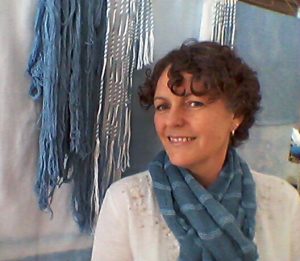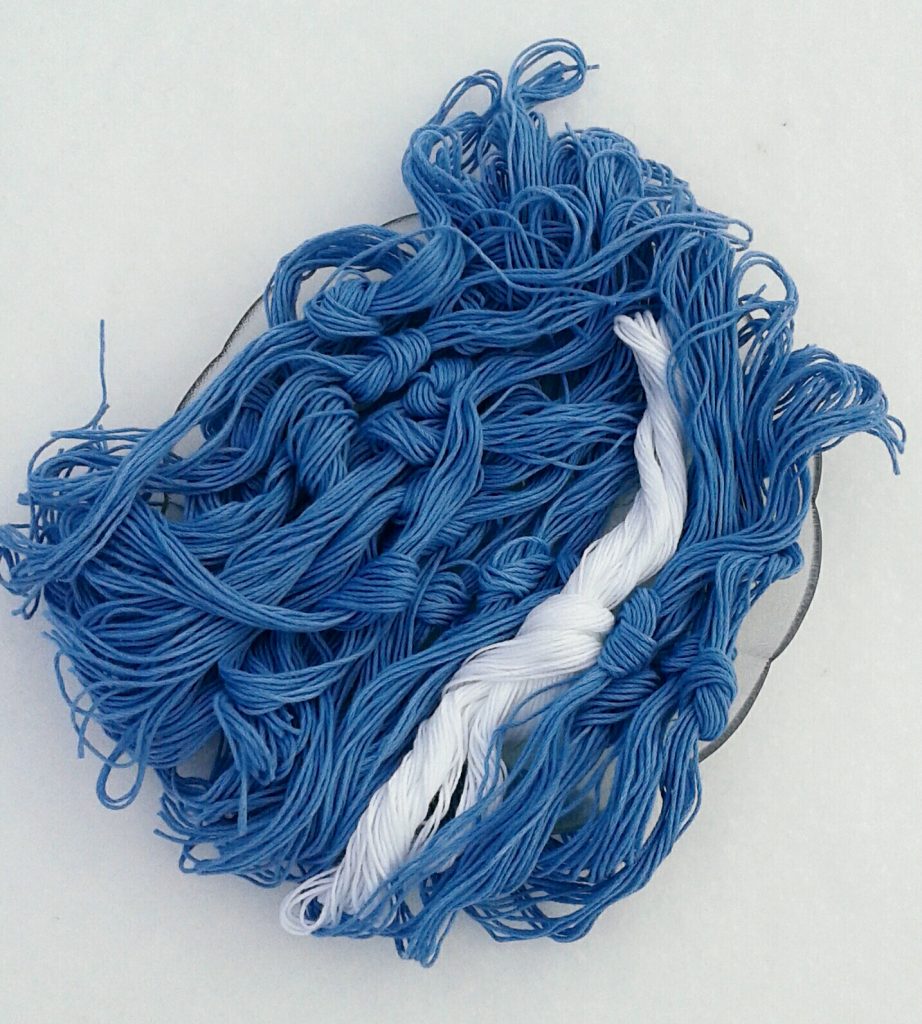 I have known Azriel Kowtek, online and in person, for some time now. She visited the Karaite Jews of America’s Shavuot extravaganza in 2015. She and her daughters recently came to visit the KJA for family Shabbat this past September.
I have known Azriel Kowtek, online and in person, for some time now. She visited the Karaite Jews of America’s Shavuot extravaganza in 2015. She and her daughters recently came to visit the KJA for family Shabbat this past September.
Her greatest biblical passion is the original source of tekhelet, the color “blue” that the Israelites are commanded to attached to the corners of our garments. The interesting thing about Azriel, and she is very open about this, is that she is not Jewish. She runs a site called “The Ancients’ Blue” where she discusses her process for dyeing tekhelet and tying tzitziot (tassels). From a Karaite perspective, I am fascinated with her work because her product meets two of the historical Karaite Jewish viewpoints on tekhelet: (i) she is using a ritually pure source, and (ii) her tekhelet is (daytime) sky blue.
Today, I interview Azriel regarding her work and her passion.
1) How did you become interested in tekhelet?
Well, the topic of woad, as the original source of tekhelet, was on the Karaites Facebook page about 4 years ago. The colour was so beautiful that I couldn’t resist looking further into it. I have a background of working with art and textiles, so I decided to keep an eye out for woad seeds to grow.
2) What is the source of your tekhelet?
My source is from the plant Isatis Tinctoria or Woad (also known as the Asp of Jerusalem), one of a few plants that produce an indigo. To the best of my knowledge, it is the only plant indigo which is native to Israel and the Arabian Peninsula. I have grown and processed the plant to extract it’s pigment, but now I am purchasing woad pigment produced in France. Interestingly, the major source for tekhelet that is in the Jewish world is also an indigo, but sourced from sea snails (Murex Trunculus).

3) Is there a part of the tekhelet dying process that is most difficult for you?
Actually it has been a challenge most of the way through to get a good product! The finding and the preparation of appropriate cotton and linen cords to dye evenly!, did take a few years of trial and error and made a few more grey hairs. Then there was the actual art of dyeing with indigo, which is very different from dyeing with other plant dyes. First the vat has to be maintained in a state of warmth and with a high PH. Then a chemical reaction has to be made to remove all the oxygen from the dye solution, in order to change the blue indigo pigment to white indigo. The vat now looks almost neon yellow. The cords are immersed and are bright yellow when it is time to bring them out. Upon coming in contact with the room air, the indigo absorbs oxygen and turns to blue almost immediately, while binding to the fabric at the same time. It is beautiful to watch this chemical reaction! All of the substances necessary to do this dyeing were readily available in ancient times! In fact woad dyed fabric is (according to some) the second oldest artifact that has ever been found. [1.] Pottery is the oldest and the wheel is younger!

4) How did you learn to tie fringes?
Well my daughters and I watched Matthew Rolland’s tying video online and I definitely needed their help! It’s a little tricky to learn initially, but once you figure out the fingering to complete one plait, the rest is easy! I have made an extensive page on how to tie these on ‘The Ancients’ Blue’ website, so hopefully it will be easy for those wishing to learn.

5) Most Jews believe that the commandment to tie fringes was given to the Israelites, and as such the person tying the fringes needs to be Jewish. Do you work with any Jewish persons to help tie fringes if the purchaser requests?
Yes, I am working directly with Matthew Rolland, who has volunteered for quite a few years to provide Karaite tzitziot for the Jewish community. There is also Nissim Ben Abraham in Eastern Europe, who volunteers tying and I am just starting to supply him with strings. If I can afford to donate dyed strings, I will continue to do so for those who volunteer their time in the Karaite Jewish community. However, I am also looking for Jewish members to help out, either by volunteering or by starting a small business tying tzitziot. As I get more orders, I feel that Matthew and I won’t have enough time to do all the tying. This project is evolving and I need time to do more research into ancient fabrics and I am working this winter on developing a wool cord to dye with woad.
6) You live in British Columbia, Canada; yet you have visited the Karaite Jews of America on two occasions. What was your experience like?
Well that has been the most awesome part of all of this! Doing this woad project has introduced me to so many amazing people. My first trip to the Karaite Jews of America in San Francisco felt like I had finally met people who thought like me! I was blessed to be immersed into the actual Egyptian Karaite Jewish culture, and I was warmly welcomed and treated as family. I made life long friends, and that was just the start! Now I am in contact with people all over the world who enquire about woad used for tzitziot. Our family’s future goal is to be able to convert, through the Karaite Jewish Community!

* * *
There you have it. I’ve learned a lot, and I hope you did too. As with all of my posts, I encourage you to do your own research to determine the most appropriate source of tekhelet for you.
[1.] http://ezinearticles.com/?Woad-in-The-Stone-Age&id=2582758


I am surprised that there is expressed concern about whether the manufacturer of tzizit is Jewish or not. The Talmud allows one to purchase tzizit made by non-Jews. Why would Karaites be more restrictive?
I’m glad she is using plants to make the dye. The Talmud recognizes that indigo is indistinguishable from the snail’s blue dye but the problem for the rabbanim is that the plant dye fades whereas the snail’s is more stable.
I prefer that we use the plant dye. Why kill any animal just to get dye? Plus the snail is tref, unkosher. So what if it fades? Just dip it in dye as needed.
Just for fun, and if memory is correct, the Talmud says that if you buy tzizit from a non-Jew you have to test the dye to make sure its from the snail. What is the test? Soak the threads in the urine of a 40 day old male child overnight. If the dye is intact, it’s kosher. I don’t think so.
This is interesting. I don’t know that Karaites are more strict than Rabbanites on this. I do know that several (~4) Rabbanie Jews I spoke to would *not* by sisiyot tied by a gentile. They would buy tekhelet died by one, though. Perhaps they are confused about the halakha or perhaps they are just adding a stringency.
Hi Marty!
Woad Indigo, Isatis Tinctoria, is very colour fast. However the Indigo from India, which is called Indigofera Tinctoria, and also called Kela Ilan by early Rabbis, is not colour fast. This is the indigo that was originally used for jeans. This is the one that the Talmud refers to, not Woad.
The Mishna does mention Woad in a Rabbinic decree regarding a kohen whose hands have been stained with Isatis Tinctoria or Woad : ‘A priest whose hands are deformed, may not raise his (hand) palms (to bless the people). R Yehudah says: even those whose hands are stained with Woad may not raise their (hand) palms, because the people stare at him’, Mishnah, Megillah, 4:7. So here, all along, was evidence that the Kohanim worked with Woad. The only way for hands to be stained with Woad is to have them submerged into the bright yellow solution and upon removing, the oxygen in the air turns the yellow to a bright blue, bonding permanently onto the hands.
For more information see the topic ‘Simply, why Woad?’ on this website; http://www.theancientsblue.com
Thanks, Azriel
Marty,- I certainly get it that you consider the Talmud (presumably the Babylonian) an authoritative text that you wish to follow and you are not used to following the Torah, let alone interpreting most of it according to the Text’s straightforward meaning. But _we_ *do* make huge efforts to follow the Torah, which commands the Children of Israel themselves to make (in effect braid) their Ṣiṣiyot throughout their generations; there is nothing in the straightforward meaning, as far as I can see, that enables Israelites to delegate this task to a non-Israelite and thus be compliant with the Miṣwah. I have never seen Qaraite exegetes claim otherwise.
Moreover, while there is no denying that attaining a colorfast woad dying is hard, it is nevertheless possible, just like attaining the same for indigo is (I have a set of Ṣiṣiyot with indigo Tekhelet which is VERY colorfast and has not faded yet despite a few years lots of exposure to air, sunlight *and* potent stain removing agents).
Zvi, you misunderstood my perspective. I don’t accept the Oral Law but I do study it to challenge my thinking. What I was implying, given that Karaism is supposed to interpret the Torah as given; and that since the Torah does not prohibit purchasing tzizit from Gentiles, why would Karaites prohibit it? Perhaps the Torah forbids us from purchasing something else from Gentiles and Karaites carryover that law to tzizit? If so, what can’t we purchase from Gentiles according to the Torah?
Also, since you say Karaites make huge efforts to observe the Torah, I wonder why you wear kippahs? As the Torah says, ‘don’t add or delete laws.’ If you say it isn’t a law and only a custom, well, that is what the rabbanim say about most of the ‘laws’ they’ve enacted.
Thank you
OK Marty. Making huge efforts is not the same as perfect success. I believe I am more successful than the Qaraites at it, but I have not reached perfection yet.
And indeed — if matters were up to me, there would be no coercion among Qaraites of head covering in Qaraite synagogues, let alone other places and events or functions. Until Qaraites of a more enlightened strand establish a synagogue in Jerusalem, I will keep bowing to this law in custom garb.
Zvi, I believe that a fair reading of the verse allows one to purchase sisiyoth from a Gentile, but the Israelite must be the one to affix it to the arba kanefoth.
Hi again Shawn; for one, considering that in antiquity our antecedents would usually make Ṣiṣiyot by creating a braid or plait on each corner out of the garment’s own threads and then added the Tekhelet cord to each one, I feel your conclusion does not rest on solid ground.
Secondly, if you purchase Ṣiṣiyot made by a heathen who might even be Christian, they might have devoted their work on it to their idol, and it is unsafe to purchase the product of idol worship.
At the very least, these two arguments should give you pause.
I have never heard of Woad. But a quick perusal interestingly shows that it was nicknamed.
“Asp of Jerusalem.”
I never could figure how they got Hilazons to dye the Mishkan in the middle of the dessert and figure it had to be a plant based dye, either Woad or Indigo depending on which dye found in Egyptian MarketsEgypt, and I figure its another Second Temple era, may I say Fetish?? Like Teffilin of which no pre Quamranic evidence has been found.
$120 dollars for an Israelite in the Post Joshua conquests who may have had numerous sons, would have had to sell himself into slavery to get a slimy snail or cuttlefish dye, both of which are carnivorous unlike the Locusts that the Yemenites have a tradition for a species that you may eat.
Im still not sure that honey is kosher considering that its a Bilbul, that Rabbinate who write about how much milk falling into a pot of meat makes it non edible per Rabbinic practice or a treif piece of meant. For all there fuss they have no problem using honey which their faulty science came up with some circular reasoning about the honey not really being a part of the bee when we know that bee enzymes are included. Maybe its no a Kzait/Olive size per ration so its kosher.
Snails eat plants and other smaller insects that it can catch and Cuttlefish are plain mean and a school of them is likely to devour a lone swimmer then not. But the dye is kosher??? Bukra Mishmeeh I say.
I wish this lady much success.
Well this is inter
A wonderful lady who provides an equally wonderful service. I purchased enough tsitsiyoth from her to tie all my talitoth and I wear them every day on my talit qatan- which provides amply opportunity to explain what they are and to speak about Torah.
Please give the link to see and possibly purchase her tzizit. I tried the link in the article as well as http://ezinearticles.com/ but I don’t see any tzizit.
Thank you
Hi Jacob!
I am so happy to hear you are using them to explain about them and speak about the Torah! It made my day!
Hi Marty!
Though I did reply above with the link to my site and information on Indigo, here it is again 🙂
http://www.theancientsblue.com
Thanks for your interest!
http://www.theancientsblue.com
Azriel is a doing a wonderful mitzvah by allowing Jews to observe what it says in the Tanak about the blue thread in our tzitziot. She should be lauded and appreciated for doing Adonai’s work.
Hi! This is my first comment here so I just wanted to give a quick shout out and say I truly enjoy reading through your blog posts. Can you recommend any other blogs/websites/forums that cover the same subjects? Thanks a lot!